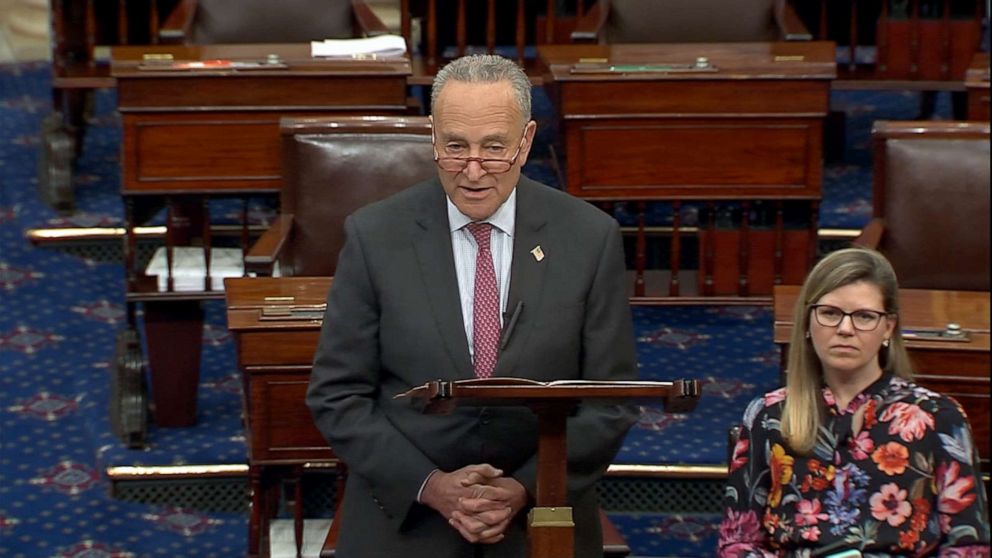The Senate Democrats held a caucus call on Saturday. Their aim was to develop a strategy for opposing a rush replacement for Supreme Court Justice Ruth Bader Ginsburg. Sam Stein and Sam Brodey of the The Daily Beast report that there was a split between liberals who advocate “a dramatic show of resistance with overt political threats” and moderates who want to remain “squarely focused on the implications that the confirmation would have on health care.”
Yet, there was agreement on the goal: keep the seat open in the hope that Joe Biden can fill it next year. The Republicans can thwart this goal, provided they stay united. The question is whether there is any strategy that can stop them.
The first arrow in the Democrats’ quiver is Senate procedure. Unfortunately, recent rule changes have all but eliminated their ability to resist. In 2013, then-Senate Majority Leader Harry Reid reached a breaking point with the Republicans’ refusal to seat President Obama’s nominees to the D.C. Circuit Court of Appeals, the nation’s second highest court. At one point during the struggle, there were four vacancies on the D.C. Circuit and Senate Republicans were arguing that none of them should be filled, but rather the court’s size should be reduced.
This led Reid to deploy the “nuclear option.” He changed the Senate’s filibuster. Instead of needing 60 votes to confirm a cabinet member or federal judge, a simple majority of 50 (plus the tie-breaking vice-president) would suffice. The only exception was Supreme Court. Its justices were considered too important to be confirmed without broader consensus. In 2017, with Republicans in control of the Senate, Mitch McConnell eliminated this exception, too, so he could shepherd Neil Gorsuch’s nomination to the Supreme Court.
Without the filibuster available as a procedural tool, the Democrats must rely on a motley collection of improvised tactics none of which are likely to thwart a GOP united behind President Trump’s nominee who he plans to announce on Saturday.
The first strategy is delay. It’s found in Rule VI of the Senate Rules.
RULE VI
QUORUM—ABSENT SENATORS MAY BE SENT FOR
Whenever upon such roll call it shall be ascertained that a quorum is not present, a majority of the Senators present may direct the Sergeant at Arms to request, and, when necessary, to compel the attendance of the absent Senators, which order shall be determined without debate; and pending its execution, and until a quorum shall be present, no debate nor motion, except to adjourn, or to recess pursuant to a previous order entered by unanimous consent, shall be in order.
The important thing here is that a quorum consists of “a majority of the Senators duly chosen and sworn,” and Vice-President Mike Pence doesn’t count for this purpose. One Democratic senator would have to be present to raise objections, but if the rest refused to show up, the Republicans would need 50 of their 53 senators in attendance in order to begin debate on the nomination. With many GOP senators campaigning for reelection, this could present some challenges.
Two of them, Susan Collins of Maine and Lisa Murkowski of Alaska, have already stated their opposition to confirming Ginsburg’s replacement before the election. If they could be convinced to join the Democrats in denying a quorum, only one more vote would be needed to stop the process. That though presents a lot of “ifs.” Collins and Murkowski oppose a pre-election nominee, but they might well back McConnell and join the rest of their Republican colleagues to stop this Democratic gambit.
The second strategy is try to prevent a vote. The same basic strategy can be deployed at the end of the debate over a nomination to prevent a vote:
RULE XII
VOTING PROCEDURENo request by a Senator for unanimous consent for the taking of a final vote on a specified date upon the passage of a bill or joint resolution shall be submitted to the Senate for agreement thereto until after a quorum call ordered for the purpose by the Presiding Officer, it shall be disclosed that a quorum of the Senate is present; and when a unanimous consent is thus given the same shall operate as the order of the Senate, but any unanimous consent may be revoked by another unanimous consent granted in the manner prescribed above upon one day’s notice.
The Democrats can also use quorum rules to harass the Republicans’ efforts to move the nomination through the committee process. The rules state that at least two members of the minority must be present in order for a hearing to proceed. The problem is, it’s not likely to be effective because the chairman can just ignore the requirement. This was demonstrated in August 2019, when Judiciary Chairman Lindsey Graham brushed off the lack of a quorum to push through the Secure and Protect Act. He also simply ignored a provision of the committee rules that state, “At the request of any member…a bill, matter, or nomination on the agenda of the Committee may be held over until the next meeting of the Committee or for one week, whichever occurs later.” No doubt, Chairman Graham would ignore these rules again to speed along the confirmation of a new Supreme Court Justice, but forcing him to do so would still be a smart strategic move. The more it looks like the Senate Republicans are breaking rules and violating norms, the less legitimate their process will appear to the public.
The Democrats might have more assured success by invoking Rule XVII to cause a two-day delay.
RULE XVII
REFERENCE TO COMMITTEES; MOTIONS TO DISCHARGE; REPORTS OF COMMITTEES; AND HEARINGS AVAILABLE5.4 Any measure or matter reported by any standing committee shall not be considered in the Senate unless the report of that committee upon that measure or matter has been available to Members for at least two calendar days (excluding Sundays and legal holidays) prior to the consideration of that measure or matter. If hearings have been held on any such measure or matter so reported, the committee reporting the measure or matter shall make every reasonable effort to have such hearings printed and available for distribution to the Members of the Senate prior to the consideration of such measure or matter in the Senate.
With only 41 days until the election, every bit of delay can help. But, as Andrew Prokop of Vox states, “If Republican senators are unconcerned about the appearances of an unseemly rush to a vote, they can certainly” get a confirmation in that window.
In theory, the House of Representatives could intervene. Speaker Nancy Pelosi could exploit Senate Rule VII on Morning Business which requires the presiding officer to “lay before the Senate…messages from the House of Representatives as may remain upon his table from any previous day’s session undisposed of.” By sending a flurry of messages to the Senate each day, she could cause some mild headaches.
Super longshots from the House. One is to impeach Trump again which is utterly implausible and would likely backfire politically but that would force the Senate to stop all business and conduct a trial. The other is to threaten to shutdown the government, using the same brinksmanship that the GOP has used in the past. Pelosi has already said that she won’t go there.
Perhaps a combination of these stalling and harassment tactics could create such a truncated confirmation process that some Republican senators balk.
If the confirmation is not completed before Election Day, some new opportunities arise. There are two Special Elections, one in Georgia and one in Arizona. The winners of those elections will be seated as soon as the results are certified. The Georgia race will go to a runoff election if no one win’s an outright majority, but the Democrats are heavily favored to win the Arizona seat. By the end of November, it’s likely that astronaut Mark Kelly, the Democrat, will have defeated incumbent Republican Martha McSally in the Senate, giving the Democrats a potentially decisive extra vote in the Lame Duck session. (But it’s also possible the Republican majority in the Senate could find a way to delay seating Kelly.)
The Republicans are not likely to be deterred by procedural moves, but cleverly employed they can raise the political costs for them. Supreme Court confirmations typically take two or three months. Obviously, any lifelong assignment should require very thorough vetting. A rushed process is politically problematic for this reason alone, so the fewer days they have to operate the most suspect their process will seem.
Additionally, the Republicans are operating right at the margin with approximately 51 votes. A delay past the election would put them under more pressure, as it’s expected they’ll be down to 50 votes once Mark Kelly is seated.
If Biden wins the election, as he currently favored to do, and the Democrats take control of the Senate, the costs of pushing through a confirmation following a Democratic sweep will be considerably higher.
If the Republicans nonetheless succeed in their effort to replace Ginsburg, the Democrats will have opportunities to respond, perhaps by expanding the Supreme Court, or ending the filibuster entirely, depriving a future GOP minority in the Senate of any real leverage. For now, delay is Chuck Schumer’s best and only option and it’s not very good.







